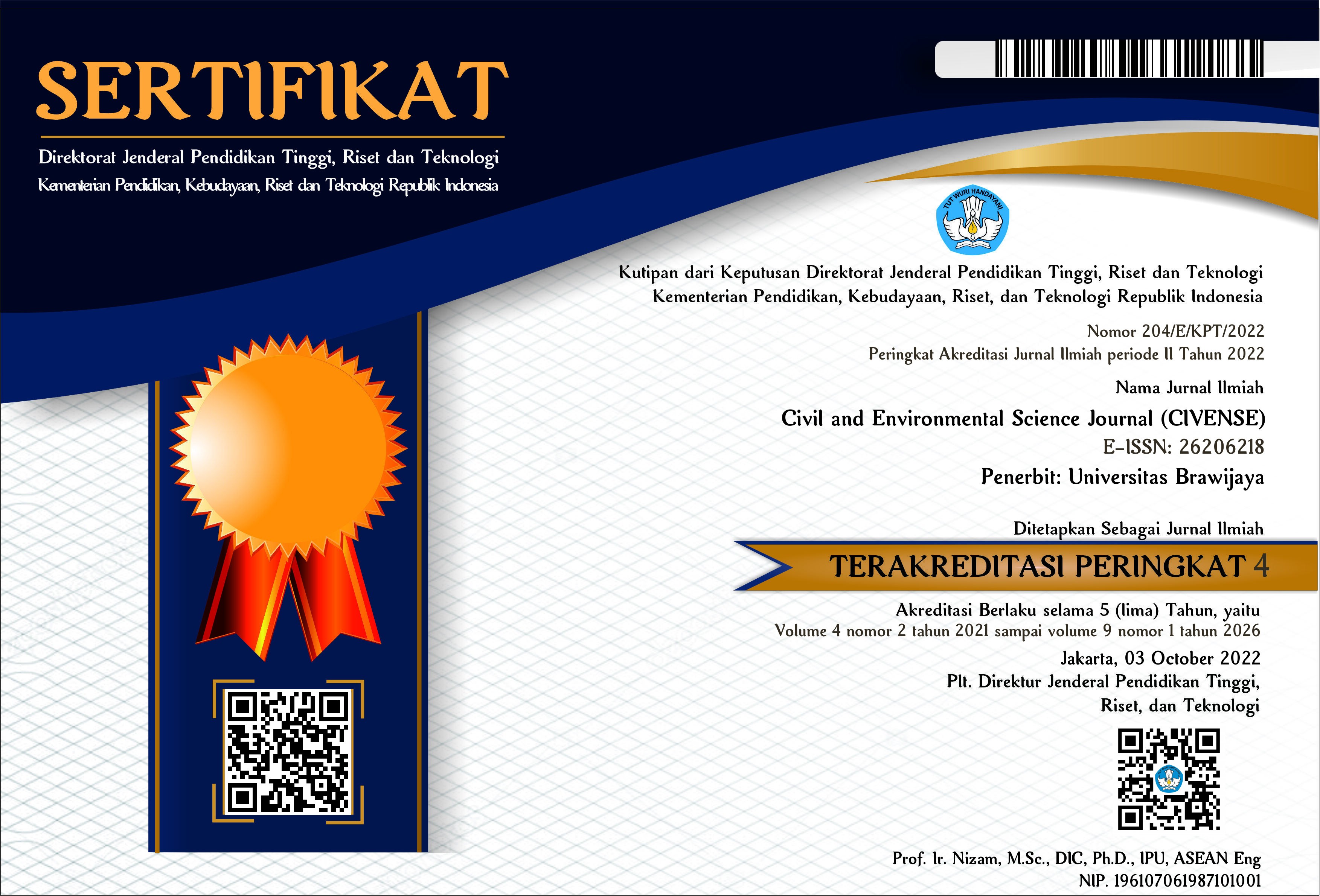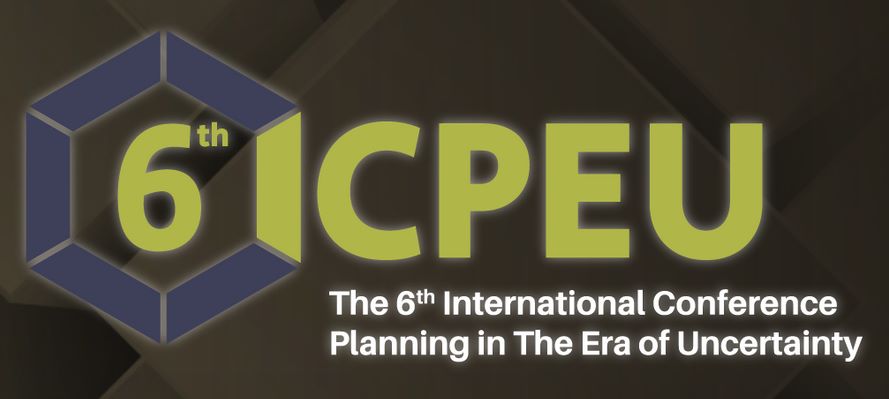The evaluation of GPM IMERG v.06 rainfall product over the Lau Simeme Watershed in Indonesia
DOI:
https://doi.org/10.21776/ub.civense.2023.00601.5Keywords:
evaluation, rainfall, remote sensing, GPM IMERG, Lau Simeme, IndonesiaAbstract
In Indonesia, rainfall is still significant spatially and temporally. In order to gain optimal results from utilising water resources, we have to ensure that the precipitation data is provided in good quality and quantity. Several spatial rainfall measurement sources have become available in recent years, such as GPM data (Global Precipitation Measure). In this study, the GPM IMERG V.06 product was evaluated using rain gauge measurements in the Lau Simeme watershed in North Sumatra Province, Indonesia. The relevance of the GPM IMERG was tested by direct comparison with observations at different time scales (daily, monthly, annual and seasonal) between 2005 and 2019. Results show that the satellite product provides poor rainfall estimations at the daily and annual time scales. However, the accuracy of GPM IMERG Final datasets is improved when temporally average to monthly timescale (R2 of 0.728, RMSE of 68.318 mm and NSE of 0.725), wet seasonal time scale (R2 of 0.673, RMSE of 79.287 mm and NSE of 0.658) and dry seasonal time scale (R2 of 0.947, RMSE of 20.356 mm and NSE of 0.924).
References
A. Utama, “Jawa ‘kehabisan air’ tahun 2040: Ratusan juta orang terancam bencana yang ‘tak pernah terbayangkan’ - BBC News Indonesia,” BBC Indonesia, 2019. https://www.bbc.com/indonesia/indonesia-49190635 (accessed Nov. 09, 2021).
Kompas.com, “Jawa, Bali dan Nusa Tenggara, Wilayah yang Sering Alami Krisis Air,” Kompas.com, 2021. https://www.kompas.com/properti/read/2021/03/22/193836621/jawa-bali-dan-nusa-tenggara-wilayah-yang-sering-alami-krisis-air (accessed Nov. 09, 2021).
H. Lauri, H. De Moel, P. J. Ward, T. A. Räsänen, M. Keskinen, and M. Kummu, “Future changes in Mekong River hydrology: Impact of climate change and reservoir operation on discharge,” Hydrol. Earth Syst. Sci., vol. 16, no. 12, pp. 4603–4619, 2012, doi: 10.5194/hess-16-4603-2012.
Y. T. Ahmadi, W. Soetopo, and P. Trijuwono, “Kajian Pola Operasi Waduk Tugu Dengan Inflow Debit Andalan Dan Inflow Debit Bangkitan Awlr,” J. Tek. Pengair., vol. 8, no. 2, pp. 205–213, 2017, doi: 10.21776/ub.pengairan.2017.008.02.6.
H. Prasanchum and A. Kangrang, “Optimal reservoir rule curves under climatic and land use changes for Lampao Dam using Genetic Algorithm,” KSCE J. Civ. Eng., vol. 22, no. 1, pp. 351–364, 2018, doi: 10.1007/s12205-017-0676-9.
J. J. Gourley and B. E. Vieux, “A method for evaluating the accuracy of quantitative precipitation estimates from a hydrologic modeling perspective,” J. Hydrometeorol., vol. 6, no. 2, pp. 115–133, Apr. 2005, doi: 10.1175/JHM408.1.
R. J. Joyce, J. E. Janowiak, P. A. Arkin, and P. Xie, “CMORPH: A method that produces global precipitation estimates from passive microwave and infrared data at high spatial and temporal resolution,” J. Hydrometeorol., vol. 5, no. 3, pp. 487–503, 2004, doi: 10.1175/1525-7541(2004)005<0487:CAMTPG>2.0.CO;2.
C. Kidd, D. R. Kniveton, M. C. Todd, and T. J. Bellerby, “Satellite rainfall estimation using combined passive microwave and infrared algorithms,” J. Hydrometeorol., vol. 4, no. 6, pp. 1088–1104, 2003, doi: 10.1175/1525-7541(2003)004<1088:SREUCP>2.0.CO;2.
S. Sorooshian, K. L. Hsu, X. Gao, H. V. Gupta, B. Imam, and D. Braithwaite, “Evaluation of PERSIANN system satellite-based estimates of tropical rainfall,” Bull. Am. Meteorol. Soc., vol. 81, no. 9, pp. 2035–2046, 2000, doi: 10.1175/1520-0477(2000)081<2035:EOPSSE>2.3.CO;2.
A. Nomleni, E. Suhartanto, and D. Harisuseno, “Estimation of flow discharge model at Temef watershed-East Nusa Tenggara using TRMM satellite data,” civense, vol. 4, no. 2, pp. 115–126, May 2021.
L. Suryaningtyas, E. Suhartanto, and R. Rispiningtati, “Hydrological analysis of TRMM (Tropical Rainfall Measuring Mission) data in Lesti Sub watershed,” Civ. Environ. Sci., vol. 003, no. 01, pp. 018–030, 2020, doi: 10.21776/ub.civense.2020.00301.3.
G. Huffman et al., “NASA GPM Integrated Multi-satellitE Retrievals for GPM (IMERG) Algorithm Theoretical Basis Document (ATBD) Version 06,” Nasa/Gsfc, no. January, p. 29, 2020, [Online]. Available: https://pmm.nasa.gov/sites/default/files/imce/times_allsat.jpg%0Ahttps://pmm.nasa.gov/sites/default/files/document_files/IMERG_ATBD_V06.pdf.
M. L. Tan and H. Santo, “Comparison of GPM IMERG, TMPA 3B42 and PERSIANN-CDR satellite precipitation products over Malaysia,” Atmos. Res., vol. 202, pp. 63–76, 2018, doi: 10.1016/j.atmosres.2017.11.006.
S. Prakash, A. K. Mitra, A. AghaKouchak, Z. Liu, H. Norouzi, and D. S. Pai, “A preliminary assessment of GPM-based multi-satellite precipitation estimates over a monsoon dominated region,” J. Hydrol., vol. 556, pp. 865–876, 2018, doi: 10.1016/j.jhydrol.2016.01.029.
M. T. Mahmoud, M. A. Al-Zahrani, and H. O. Sharif, “Assessment of global precipitation measurement satellite products over Saudi Arabia,” J. Hydrol., vol. 559, pp. 1–12, 2018, doi: 10.1016/j.jhydrol.2018.02.015.
S. Khodadoust Siuki, B. Saghafian, and S. Moazami, “Comprehensive evaluation of 3-hourly TRMM and half-hourly GPM-IMERG satellite precipitation products,” Int. J. Remote Sens., vol. 38, no. 2, pp. 558–571, 2017, doi: 10.1080/01431161.2016.1268735.
M. N. Anjum et al., “Performance evaluation of latest integrated multi-satellite retrievals for Global Precipitation Measurement (IMERG) over the northern highlands of Pakistan,” Atmos. Res., vol. 205, pp. 134–146, 2018, doi: 10.1016/j.atmosres.2018.02.010.
D. C. Goodrich, J. M. Faurès, D. A. Woolhiser, L. J. Lane, and S. Sorooshian, “Measurement and analysis of small-scale convective storm rainfall variability,” J. Hydrol., vol. 173, no. 1–4, pp. 283–308, 1995, doi: 10.1016/0022-1694(95)02703-R.
R. Woods and M. Sivapaln, “A synthesis of space‐time variability in storm response Rainfall runoff.pdf,” Water Resour. Res., vol. 35, no. 8, pp. 2469–2485, 1999, doi: 0043-1397/99/1999WR9000145.
J. E. Nash and J. V Sutcliffe, “River flow forecasting through conceptual models part I - A discussion of principles,” J. Hydrol., vol. 10, no. 3, pp. 282–290, 1970, doi: 10.1016/0022-1694(70)90255-6.
M. Bal, A. K. Dandpat, and B. Naik, “Hydrological modeling with respect to impact of land-use and land-cover change on the runoff dynamics in Budhabalanga river basing using ArcGIS and SWAT model,” Remote Sens. Appl. Soc. Environ., vol. 23, 2021, doi: 10.1016/j.rsase.2021.100527.
D. N. Moriasi, J. G. Arnold, M. W. Van Liew, R. L. Bingner, R. D. Harmel, and T. L. Veith, “Model evaluation guidelines for systematic quantification of accuracy in watershed simulations,” Trans. ASABE, vol. 50, no. 3, pp. 885–900, 2007.
K. V. SeethaRam, “Three Level Rule Curve for Optimum Operation of a Multipurpose Reservoir using Genetic Algorithms,” Water Resour. Manag., vol. 35, no. 1, pp. 353–368, 2021, doi: 10.1007/s11269-020-02738-7.
D. . Goldberg and J. H. Holland, “Genetic Algorithms and Machine Learning,” in Machine Learning 3, 1988, pp. 95–99.
H. Ouatiki et al., “Evaluation of TRMM 3B42 V7 rainfall product over the Oum Er Rbia watershed in Morocco,” Climate, vol. 5, no. 1, 2017, doi: 10.3390/cli5010001.
Downloads
Published
How to Cite
Issue
Section
License
Copyright (c) 2023 Bachtiar Malthus Hutagaol, James E. Ball, Ery Suhartanto, Sri Wahyuni

This work is licensed under a Creative Commons Attribution-NonCommercial 4.0 International License.
Authors who publish with this journal agree to the following terms:
Authors retain copyright and grant the journal right of first publication with the work simultaneously licensed under a Attribution-NonCommercial 4.0 International License that allows others to share the work with an acknowledgement of the work's authorship and initial publication in this journal.
Authors are able to enter into separate, additional contractual arrangements for the non-exclusive distribution of the journal's published version of the work (e.g., post it to an institutional repository or publish it in a book), with an acknowledgement of its initial publication in this journal.
Authors are permitted and encouraged to post their work online (e.g., in institutional repositories or on their website) prior to and during the submission process, as it can lead to productive exchanges, as well as earlier and greater citation of published work (See the Effect of Open Access).














